|
The Celebrity Collector
Billy Gray, Bud from "Father Knows Best,"
Collects Racing Motorcycles
By Ken Hall
Billy Gray collects motorcycles and bike parts, but if you're expecting to
read a story about Harley-Davidsons, Yamahas, Hondas and Triumphs, forget it.
Gray's collection comprises names like J.A.P., Jawa, Westlake and G.M., and if
you're unfamiliar with them then you're probably not acquainted with Class A
Speedway competitive motorcycle racing, a longtime passion of Gray's.
The
child actor who played Patricia Neal's inquisitive son in the 1951 science
fiction movie, "The Day the Earth Stood Still", has been a motorcycle enthusiast
since his days on "Father Knows Best," on which he played "Bud (James, Jr.)
Anderson." In fact, he rode a motorcycle to the studio (his first one, a 500cc
Matchless British racing bike) beginning around 1953, when he was just
15.
"The studio executives never had a problem with my riding the Matchless
to work," Gray said, "but a few years later, when they found out I was taking
another bike a Triumph 650 out to the drag racing tracks on weekends and
getting it up to 120 miles an hour on nitro-methane fuel, they kind of went nuts
and made me stop." He added, "I still say the street is a much more dangerous
environment."
Today, Gray's motorcycles he probably has dozens, but they're
in varying degrees of assembly and disassembly, except for a half-dozen or so
complete ones are in his garage and beneath outdoor tarps at his home in
Topanga, Calif., between Malibu and Santa Monica. He's lived in the house since
1957, while "Father Knows Best" was still going strong, when he paid $75 a month
in rent for the basement apartment.
"The owner came to me one day and said,
'I'm going to sell this house and you should really think about buying it.'
Buying a house was the furthest thing from my mind. I was still a teenager. But
I figured out I had enough for a down payment so I went ahead and bought the
place. Smartest thing I've ever done." It's been a home for Gray and his
motorcycle "museum" ever since.
Class A Speedway motorcycle racing is
something Gray has been involved with since around 1970, about the time his
acting career was moribund. He raced competitively at dirt tracks in southern
California for about 25 years, until 1995. For the past ten years, he's been a
spectator for the most part, although he laments the sport is shrinking. "Only a
few tracks in the U.S. even stage races," he said.
Participants in Class A
racing compete on oval-shaped dirt tracks. A race usually lasts four laps, with
each lap measuring 1/8-mile or 1/10 mile. There are no dips or hills, as with
some other biking competitions. The trick in Class A racing is to get traction,
and that's "a very delicate thing," Gray said, because the bikes are light
(about 180 pounds) and the rear wheels are always spinning.
"The front wheel
can just come up on you at any time and you suddenly find yourself popping a
wheelie without even wanting to," Gray said. Because a turn is always imminent,
getting up to a high speed is nearly impossible; the bikes, at 500cc, top out at
only 55-60 on the straightaway. And that's only for a second or two, until the
next turn. On some of the longer tracks (1/2-mile), a rider may reach 90
mph.
The motorcycles for this niche sport are definitely not street legal.
They have no brakes, only one gear and are engineered to just turn left (the
races are run counter-clockwise). The front wheel looks like it was taken off a
bicycle (23" rims) and the forks have very little "travel." In short, these
motorcycles are built for one purpose and one purpose only to be raced in
Class A Speedway competition.
The first Class A bike Gray owned was a J.A.P.,
which stands for the initials of its British inventor in the 1920s (the sport
was invented around that time, in New Zealand). "In the '30s and '40s, it was
very chic in Hollywood for actors like Errol Flynn to make the scene and watch
the J.A.P. bikes race at places like Gilmore Stadium and Lincoln Park," Gray
said. The J.A.P. dominated the sport all the way up to the 1960s and early
'70s.
Then, the Jawa a Czech bike arrived on the scene, having been
introduced to America by five-time British champ Ivan Major (Class A racing was
born in Europe and continues to be popular there). "The geometry was different
with the Jawa," Gray said. "The driver stood up for turns and sat down in the
straightaway. It was much easier to ride, and had more RPMs 8,000, vs. just
5,000 for the J.A.P."
In the mid-1970s, another shift occurred. Suddenly,
everybody had to have a Westlake bike, from Britain. A longer stroke and bore
meant more torque, which meant more power. And it had a four-valve engine, an
immediate upgrade over the two-valve Jawa. To keep pace, Jawa introduced a
single overhead cam engine, which is still used today. But the final player was
yet to be unveiled.
That came in the form of the G.M. motorcycle (it's an
Italian abbreviation, no relation to General Motors). The G.M. made a bike
nicknamed the "laydown" because the tilt of the engine (about 45 degrees) makes
it look as if it's laying on its side. The "laydown" has become the industry
standard and Jawa makes one, too. Those two players Jawa and G.M. remain
standing today.
Gray's collection consists of four vintage two-valve Jawas;
one single overhead cam engine Jawa; a four-valve pushrod Westlake; a G.M.
single overhead cam engine (minus frame); but, alas, no J.A.P. examples. He
owned several earlier on, but they're gone now. And, of course, he has all
manner of frames, wheels, engine plates, clutches, heads, transmissions and
other parts, most of them in his jam-packed garage.
When Gray was racing, an
announcer at Irwindale Raceway in California dubbed his bike the "Orange Crate
Special" and the "Orange Blossom Special" because of the loud orange wheel
covers. He said the races were physically taxing, with the riders not shy about
jostling and bumping for position. He estimates he took 1,000 spills or more in
his career. His most serious injury: a separated collarbone, sustained when he
hit a crash wall. "That cost me six weeks," he said.
Billy Gray was born
William Thomas Gray on January 13, 1938, in Los Angeles. He had an early and
easy "in" to Hollywood: his mother, Beatrice Gray, was a longtime leading lady
in the '30s and '40s who had roles in films like Otto Preminger's "Laura," with
Gene Tierney and Dana Andrews. In fact, she and Billy both had parts (albeit in
separate scenes) in "Abbott and Costello Meet Frankenstein" (1943), with Boris
Karloff.
In 1951, at age 13, he appeared in the film "Jim Thorpe
All-American," starring Burt Lancaster in the lead role. Gray played Thorpe as a
child. Later that year, he was picked to play Patricia Neal's pre-teen son in
the mesmerizing sci-fi movie, "The Day the Earth Stood Still." Michael Rennie
played the part of the alien who befriended the young boy. Sam Jaffe also
starred.
In 1953, Gray was slated to play "Tag Oakley" in the hit TV western
"Annie Oakley." But he opted instead to co-star alongside Robert Young, Jane
Wyatt, Elinor Donahue and Lauren Chapin in one of the longest-running and
arguably most white-bread situation comedies of all time, "Father Knows Best."
In a 1983 interview, Gray summed up what he thought of the program:
"I wish
there was some way I could tell the kids not to believe it. The dialogue, the
situations, the characters they were all totally false. The show did everyone
a disservice. The girls were always trained to use their feminine wiles, to
pretend to be helpless to attract men. The show contributed to a lot of the
problems between men and women that we see today." He added, "I think we were
all well motivated, but what we did was run a hoax. 'Father Knows Best'
purported to be a reasonable facsimile of life. And the bad thing is, the model
is so deceitful. It usually revolved around not wanting to tell the truth,
either out of embarrassment, or not wanting to hurt someone. If I could say
anything to make up for all the years I lent myself to (that), it would be, 'You
Know Best.'"
Today, Gray remains friendly with the others in the cast,
including Jane Wyatt, who played the matriarch of the Anderson clan and is now
in her 90s. Robert Young, the father and central figure of the show who went on
to enjoy further success on "Marcus Welby, M.D.," passed away in 1988. In 1977,
the cast reunited for a television special titled, "Father Knows Best: Home for
Christmas."
Gray endured a personal and professional crisis in 1962 when he
was arrested for marijuana possession. It was a scandalous charge at the time,
and the "drug addict" label haunted him and cost him work for years thereafter.
Things only got worse in 1971 when he took a role in the film, "Dusty and Sweets
McGee," playing the part of a greasy-haired heroin dealer with the street name
"City Life."
He must have been convincing, because the movie critic Leonard
Maltin lumped Gray in with the actual addicts and pushers who were recruited for
the film. Maltin wrote in his annual movie encyclopedia, "Among real-life
addicts and pushers shown is Billy Gray of TV's 'Father Knows Best.'" Despite
Gray's complaints, the sentence remained in Maltin's guide for more than 20
years.
Finally, in 1998, Gray sued Martin, successfully, to have the line
taken out. He also got a public apology from Maltin, who said, "I did not intend
to convey that Billy Gray was a heroin addict or a pusher." There was also a
financial settlement, the terms of which were not disclosed. Now, with his name
cleared once and for all, Gray can enjoy life, Class A Speedway motorcycle
racing, and his collection of bikes.
Gray has a dream of reviving Class A
bike racing in the States, with a redesigned course diamond-shaped, not oval,
which would make for sharper turns and make for more compelling competition. He
also envisions pitting just two riders against one another per race not a
field of 4 or 6, as it is now with the winner of each race advancing in a
round-robin tournament system. He plans to videotape some footage and pitch the
idea to the Speed Channel or other networks.
Gray is also an inventor. As
co-owner of a company called BigRock Engineering, he markets several products,
all of them his idea: the "Love'n'Thumb" self-massager (inspired by a trip to
Hawaii, where he was helping his brother clear some land and came down with a
sore back); a line of high-tech guitar picks; and a candleholder for
jack-o-lanterns that has sold over seven million units.
Fans of Billy Gray
may visit the star online at www.billygray.com.
|
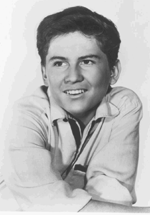
Gray played "Bud Anderson"
on "Father Knows Best"
from age 16 to 22.
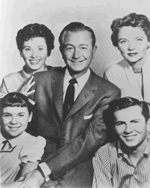
The cast from "Father Knows Best" (clockwise from center): Robert Young, Jane
Wyatt, Billy Gray,
Lauren Chapin, Elinor Donahue.
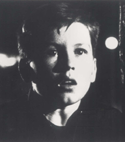
Gray in a publicity still from "The Day the Earth Stood Still."
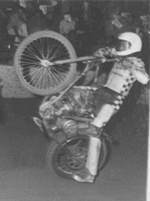
Billy gets a little too much traction in the middle of a turn and pops an
unintentional wheelie.
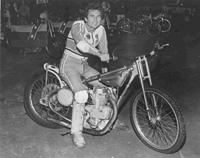
Gray, minus helmet, takes a break between races. That's a Westlake he's on, a
British bike.
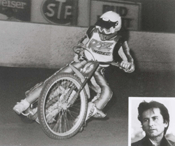
Gray raced competitively for 25 years, 1970-1995.
|